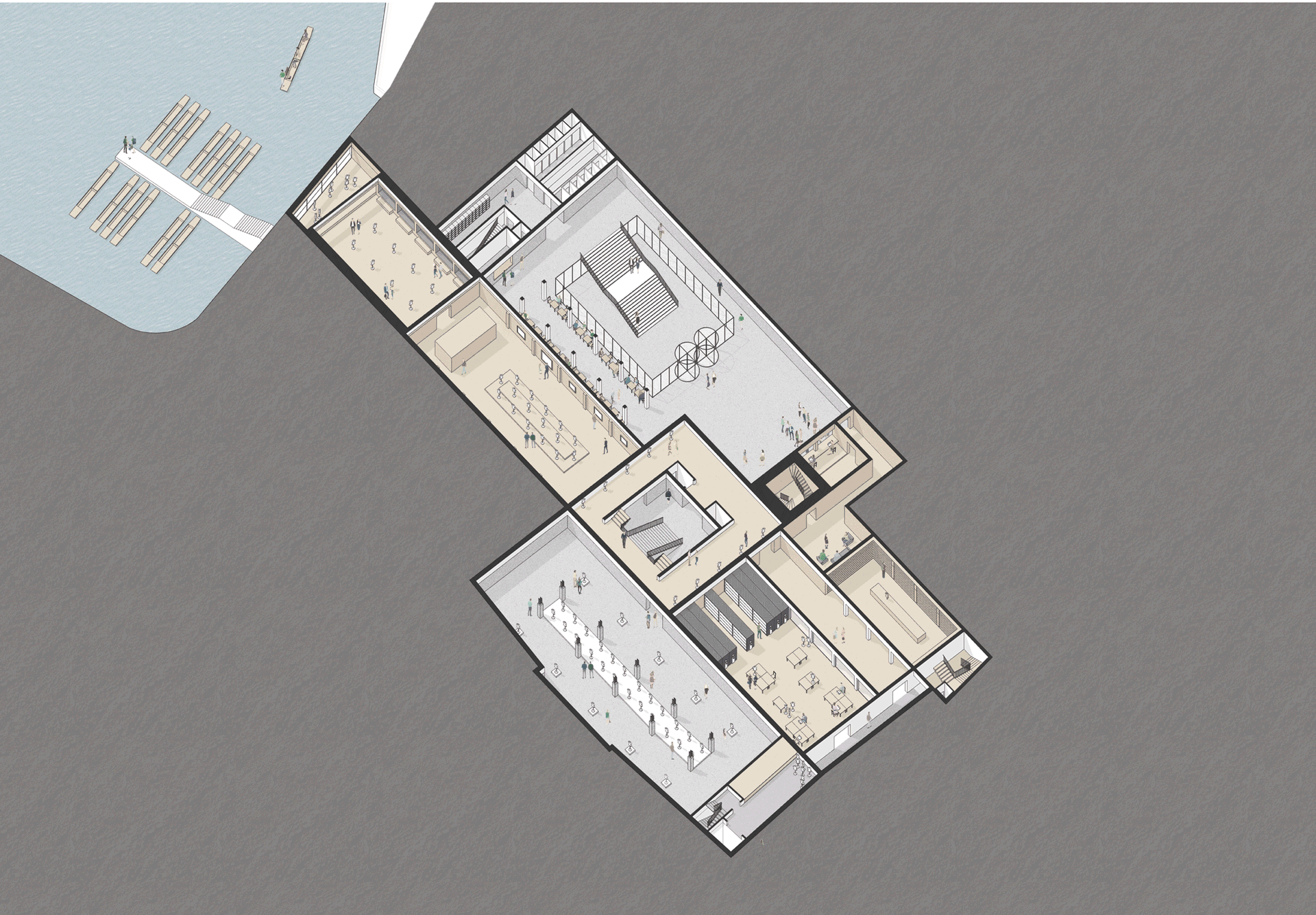St Homobonus College is a proposed centre of excellence for dress culture in the historic university city of Cambridge, England. Inspired by the University’s traditional dress culture, which has had a huge influence on both ‘gown’ and ‘town’ Cambridge, as well as (student) fashion around the world, St Homobonus College rethinks the college typology to give dress culture in general, but particularly local dress culture, a stage in soon to be abandoned University buildings. Academics and craftsmen, higher education and vocational training, are all united, as a research centre, a school of tailoring, and a bespoke salon, among others, are brought together and linked. The theatricality of fashion, and specifically ideas surrounding dandyism, run throughout the design and the images I have created.
KOOZ Who influences you graphically?
STEF DINGEN A broad range of artists continuously inspire me. Generally speaking I am a great admirer of Johannes Vermeer’s genre paintings, François Boucher’s depictions of Madame de Pompadour and other enlightened women, and John Singer Sargent’s fabulous society portraits. For this project specifically, Victorian fashion prints and a variety of fashion photographers, most importantly Cecil Beaton, have influenced my graphic style. These fashionable images may seem frivolous at first, but I find them to be interesting carriers of cultural values regarding relevant societal themes, such as – perhaps most visibly – gender equality.
KOOZ What defined the representational language of the project? To what extent was this developed through the project and the process of research?
SD As I was researching dress culture in Cambridge, I found out dandyism was a real thing among young Victorian and Edwardian men attending university there. The castle-like architecture of Cambridge’s most famous colleges formed the perfect stage set against which these dandies could flaunt their dazzling outfits. Among the most famous of these dandies was Cecil Beaton, once an undergraduate at St John’s College, and later arguably Britain’s most influential fashion photographer of the twentieth century. It was only natural to explore his work, and implement elements of it in both my design and its representation. When I found out that the University of Cambridge has in fact produced a number of influential figures in fashion – from couturier Norman Hartnell and photographer Lord Snowdon, to fashion critic Suzy Menkes and style icon Tilda Swinton – it became even more clear that fashion imagery should be at the basis of my images.

KOOZ What is your take on the architectural silhouette? What defines the varied nature of these figures within your images?
SD People bring my images to life and help me tell stories. I find that to populate my images, and to carefully consider not only how people would behave in and around my design, but also who these people are, helps to make sense of my own design. In this case, through the figures that I used, I wanted to root St Homobonus College in Cambridge’s rich history on the one hand, and question the tension between tradition and modernity, that has been so present throughout my research and design, on the other. So I chose to alternate cut-outs from Victorian fashion prints, which I think are clearly reflective of certain outdated ideals regarding gender roles for example, with a diverse range of contemporary, famous Cambridge alumni, including Stephen Hawking, Rachel Weisz, Tom Hiddleston, Naomie Harris, Emma Thompson, and indeed Tilda Swinton. Simultaneously, populating these images was an audit of sorts, to check whether or not the design I had made was actually a place where seeing and being seen was an inherent part of experiencing this building the way I hoped it would be.
KOOZ What was your work process in terms of project development and production of images? How important was the preliminary sketch?
SD Throughout the design process I have used cut-outs of Cecil Beaton sitters among others, to populate preliminary sketches and simple clay renders. As I hoped to create a contemporary reimagining of the Cambridge College, one that would also be a stage set for dandyism, these early drawings helped to see if I was going in the right direction at all.
KOOZ What programs did you use?
SD For 3D modelling I used SketchUp, then simple V-Ray renders are the basis of all visualisations that are mostly made in Photoshop. Illustrator is used to create cleaned up line drawings for the axonometric.
KOOZ When talking about theatre and theatricality did you ever think of exploring the project through this medium? What defined the use of the drawing?
SD I have made a series of simple study models that literally explored my building as a theatre set. However, eventually I suppose it is more the theatricality one could see in the grand staircase of the Opéra Garnier for example, that I am looking for here. It is all about that idea of spectators becoming actors as they climb those stairs, dressed to the nines, while being looked at from the surrounding galleries. Also, these drawings allowed me to show more of the ideas behind my entire research and design project at large. The contrast between the Victorian cut-outs and contemporary figures I talked about earlier, for example, is strongest in the flat surface of a drawing.
KOOZ What role does the axonometric play as a unique orthogonal projection through which you reveal the project?
SD The axonometric is a very straight-forward type of drawing to show different types of spatial relations in a building. In this case I wanted to make interior and exterior easily distinguishable, I wanted to show vertical relations between different spaces through voids and roof lights, and I hoped to show my proposal for St Homobonus College fits into Cambridge’s historic, collegiate core. Making this animated axonometric seemed to me to be the clearest way to achieve all of this, while also giving the opportunity to relate all the moments I captured in other drawings to its particular place within the building.

